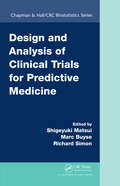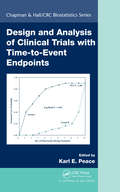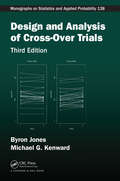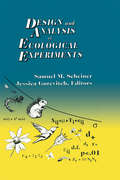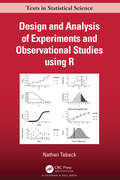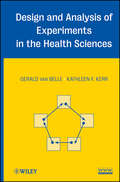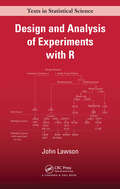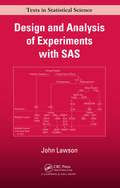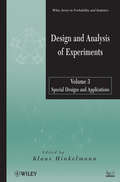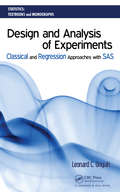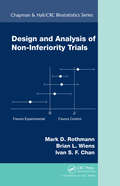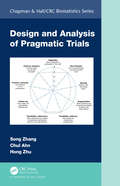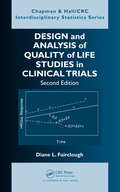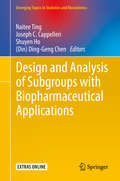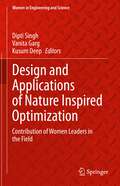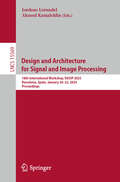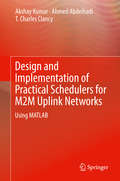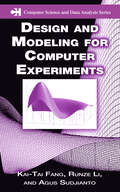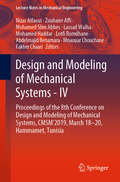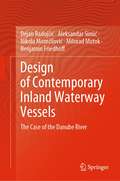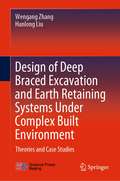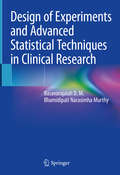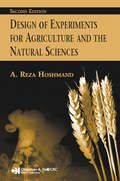- Table View
- List View
Design and Analysis of Clinical Trials for Predictive Medicine (Chapman & Hall/CRC Biostatistics Series)
by Richard Simon Shigeyuki Matsui Marc BuyseDesign and Analysis of Clinical Trials for Predictive Medicine provides statistical guidance on conducting clinical trials for predictive medicine. It covers statistical topics relevant to the main clinical research phases for developing molecular diagnostics and therapeutics-from identifying molecular biomarkers using DNA microarrays to confirming
Design and Analysis of Clinical Trials with Time-to-Event Endpoints (Chapman & Hall/CRC Biostatistics Series)
by Karl E. PeaceUsing time-to-event analysis methodology requires careful definition of the event, censored observation, provision of adequate follow-up, number of events, and independence or "noninformativeness" of the censoring mechanisms relative to the event. Design and Analysis of Clinical Trials with Time-to-Event Endpoints provides a thorough presentation o
Design and Analysis of Cross-Over Trials (ISSN)
by Byron Jones Michael G. KenwardDesign and Analysis of Cross-Over Trials is concerned with a specific kind of comparative trial known as the cross-over trial, in which subjects receive different sequences of treatments. Such trials are widely used in clinical and medical research, and in other diverse areas such as veterinary science, psychology, sports science, and agriculture.T
Design and Analysis of Ecological Experiments
by Sam ScheinerThe goal of this book is to make some underutilized but potentially very useful methods in experimental design and analysis available to ecologists, and to encourage better use of standard statistical techniques. Ecology has become more and more an experimental science in both basic and applied work,but experiments in the field and in the laboratory often present formidable statistical difficulties. Organized around providing solutions to ecological problems, this book offers ways to improve the statistical aspects of conducting manipulative ecological experiments, from setting them up to interpreting and reporting the results. An abundance of tools, including advanced approaches, are made available to ecologists in step-by-step examples, with computer code provided for common statistical packages. This is an essential how-to guide for the working ecologist and for graduate students preparing for research and teaching careers in the field of ecology.
Design and Analysis of Experiments
by Angela Dean Daniel Voss Danel DraguljićHandbook of Design and Analysis of Experiments provides a detailed overview of the tools required for the optimal design of experiments and their analyses. The handbook gives a unified treatment of a wide range of topics, covering the latest developments. This carefully edited collection of 25 chapters in seven sections synthesizes the state of the art in the theory and applications of designed experiments and their analyses. Written by leading researchers in the field, the chapters offer a balanced blend of methodology and applications. The first section presents a historical look at experimental design and the fundamental theory of parameter estimation in linear models. The second section deals with settings such as response surfaces and block designs in which the response is modeled by a linear model, the third section covers designs with multiple factors (both treatment and blocking factors), and the fourth section presents optimal designs for generalized linear models, other nonlinear models, and spatial models. The fifth section addresses issues involved in designing various computer experiments. The sixth section explores "cross-cutting" issues relevant to all experimental designs, including robustness and algorithms. The final section illustrates the application of experimental design in recently developed areas. This comprehensive handbook equips new researchers with a broad understanding of the field's numerous techniques and applications. The book is also a valuable reference for more experienced research statisticians working in engineering and manufacturing, the basic sciences, and any discipline that depends on controlled experimental investigation.
Design and Analysis of Experiments and Observational Studies using R (Chapman & Hall/CRC Texts in Statistical Science)
by Nathan TabackIntroduction to Design and Analysis of Scientific Studies exposes undergraduate and graduate students to the foundations of classical experimental design and observational studies through a modern framework - The Rubin Causal Model. A causal inference framework is important in design, data collection and analysis since it provides a framework for investigators to readily evaluate study limitations and draw appropriate conclusions. R is used to implement designs and analyse the data collected. Features: Classical experimental design with an emphasis on computation using tidyverse packages in R. Applications of experimental design to clinical trials, A/B testing, and other modern examples. Discussion of the link between classical experimental design and causal inference. The role of randomization in experimental design and sampling in the big data era. Exercises with solutions. Instructor slides in RMarkdown, a new R package will be developed to be used with book, and a bookdown version of the book will be freely available. The proposed book will emphasize ethics, communication and decision making as part of design, data analysis, and statistical thinking.
Design and Analysis of Experiments in the Health Sciences
by Gerald Van Belle Kathleen F. KerrAn accessible and practical approach to the design and analysis of experiments in the health sciencesDesign and Analysis of Experiments in the Health Sciences provides a balanced presentation of design and analysis issues relating to data in the health sciences and emphasizes new research areas, the crucial topic of clinical trials, and state-of-the- art applications.Advancing the idea that design drives analysis and analysis reveals the design, the book clearly explains how to apply design and analysis principles in animal, human, and laboratory experiments while illustrating topics with applications and examples from randomized clinical trials and the modern topic of microarrays. The authors outline the following five types of designs that form the basis of most experimental structures:Completely randomized designsRandomized block designsFactorial designsMultilevel experimentsRepeated measures designsA related website features a wealth of data sets that are used throughout the book, allowing readers to work hands-on with the material. In addition, an extensive bibliography outlines additional resources for further study of the presented topics.Requiring only a basic background in statistics, Design and Analysis of Experiments in the Health Sciences is an excellent book for introductory courses on experimental design and analysis at the graduate level. The book also serves as a valuable resource for researchers in medicine, dentistry, nursing, epidemiology, statistical genetics, and public health.
Design and Analysis of Experiments with R
by John LawsonDesign and Analysis of Experiments with R presents a unified treatment of experimental designs and design concepts commonly used in practice. It connects the objectives of research to the type of experimental design required, describes the process of creating the design and collecting the data, shows how to perform the proper analysis of the data,
Design and Analysis of Experiments with SAS (Chapman & Hall/CRC Texts in Statistical Science)
by John LawsonA culmination of the author's many years of consulting and teaching, Design and Analysis of Experiments with SAS provides practical guidance on the computer analysis of experimental data. It connects the objectives of research to the type of experimental design required, describes the actual process of creating the design and collecting the data, s
Design and Analysis of Experiments, Special Designs and Applications
by Klaus HinkelmannProvides timely applications, modifications, and extensions of experimental designs for a variety of disciplinesDesign and Analysis of Experiments, Volume 3: Special Designs and Applications continues building upon the philosophical foundations of experimental design by providing important, modern applications of experimental design to the many fields that utilize them. The book also presents optimal and efficient designs for practice and covers key topics in current statistical research.Featuring contributions from leading researchers and academics, the book demonstrates how the presented concepts are used across various fields from genetics and medicinal and pharmaceutical research to manufacturing, engineering, and national security. Each chapter includes an introduction followed by the historical background as well as in-depth procedures that aid in the construction and analysis of the discussed designs. Topical coverage includes:Genetic cross experiments, microarray experiments, and variety trialsClinical trials, group-sequential designs, and adaptive designsFractional factorial and search, choice, and optimal designs for generalized linear modelsComputer experiments with applications to homeland securityRobust parameter designs and split-plot type response surface designsAnalysis of directional data experimentsThroughout the book, illustrative and numerical examples utilize SAS®, JMP®, and R software programs to demonstrate the discussed techniques. Related data sets and software applications are available on the book's related FTP site.Design and Analysis of Experiments, Volume 3 is an ideal textbook for graduate courses in experimental design and also serves as a practical, hands-on reference for statisticians and researchers across a wide array of subject areas, including biological sciences, engineering, medicine, and business.
Design and Analysis of Experiments: Classical and Regression Approaches with SAS
by Leonard C. OnyiahUnlike other books on the modeling and analysis of experimental data, Design and Analysis of Experiments: Classical and Regression Approaches with SAS not only covers classical experimental design theory, it also explores regression approaches. Capitalizing on the availability of cutting-edge software, the author uses both manual meth
Design and Analysis of Non-Inferiority Trials (Chapman & Hall/CRC Biostatistics Series)
by Mark D. Rothmann Brian L. Wiens Ivan S.F. ChanThe increased use of non-inferiority analysis has been accompanied by a proliferation of research on the design and analysis of non-inferiority studies. Using examples from real clinical trials, Design and Analysis of Non-Inferiority Trials brings together this body of research and confronts the issues involved in the design of a non-inferiority tr
Design and Analysis of Pragmatic Trials (Chapman & Hall/CRC Biostatistics Series)
by Hong Zhu Song Zhang Chul AhnThis book begins with an introduction of pragmatic cluster randomized trials (PCTs) and reviews various pragmatic issues that need to be addressed by statisticians at the design stage. It discusses the advantages and disadvantages of each type of PCT, and provides sample size formulas, sensitivity analyses, and examples for sample size calculation. The generalized estimating equation (GEE) method will be employed to derive sample size formulas for various types of outcomes from the exponential family, including continuous, binary, and count variables. Experimental designs that have been frequently employed in PCTs will be discussed, including cluster randomized designs, matched-pair cluster randomized design, stratified cluster randomized design, stepped-wedge cluster randomized design, longitudinal cluster randomized design, and crossover cluster randomized design. It demonstrates that the GEE approach is flexible to accommodate pragmatic issues such as hierarchical correlation structures, different missing data patterns, randomly varying cluster sizes, etc. It has been reported that the GEE approach leads to under-estimated variance with limited numbers of clusters. The remedy for this limitation is investigated for the design of PCTs. This book can assist practitioners in the design of PCTs by providing a description of the advantages and disadvantages of various PCTs and sample size formulas that address various pragmatic issues, facilitating the proper implementation of PCTs to improve health care. It can also serve as a textbook for biostatistics students at the graduate level to enhance their knowledge or skill in clinical trial design. Key Features: Discuss the advantages and disadvantages of each type of PCTs, and provide sample size formulas, sensitivity analyses, and examples. Address an unmet need for guidance books on sample size calculations for PCTs; A wide variety of experimental designs adopted by PCTs are covered; The sample size solutions can be readily implemented due to the accommodation of common pragmatic issues encountered in real-world practice; Useful to both academic and industrial biostatisticians involved in clinical trial design; Can be used as a textbook for graduate students majoring in statistics and biostatistics.
Design and Analysis of Quality of Life Studies in Clinical Trials (Chapman & Hall/CRC Interdisciplinary Statistics)
by Diane L. FaircloughDesign Principles and Analysis Techniques for HRQoL Clinical TrialsSAS, R, and SPSS examples realistically show how to implement methods Focusing on longitudinal studies, Design and Analysis of Quality of Life Studies in Clinical Trials, Second Edition addresses design and analysis aspects in enough detail so that readers can apply statistical meth
Design and Analysis of Subgroups with Biopharmaceutical Applications (Emerging Topics in Statistics and Biostatistics)
by Naitee Ting Shuyen Ho Joseph C. Cappelleri Din Ding-Geng ChenThis book provides an overview of the theories and applications on subgroups in the biopharmaceutical industry. Drawing from a range of expert perspectives in academia and industry, this collection offers an overarching dialogue about recent advances in biopharmaceutical applications, novel statistical and methodological developments, and potential future directions.The volume covers topics in subgroups in clinical trial design; subgroup identification and personalized medicine; and general issues in subgroup analyses, including regulatory ones. Included chapters present current methods, theories, and case applications in the diverse field of subgroup application and analysis. Offering timely perspectives from a range of authoritative sources, the volume is designed to have wide appeal to professionals in the pharmaceutical industry and to graduate students and researchers in academe and government.
Design and Applications of Nature Inspired Optimization: Contribution of Women Leaders in the Field (Women in Engineering and Science)
by Kusum Deep Dipti Singh Vanita GargThis book gives a detailed information of various real-life applications from various fields using nature inspired optimization techniques. These techniques are proven to be efficient and robust in many difficult problems in literature. The authors provide detailed information about real-life problems and how various nature inspired optimizations are applied to solve these problems. The authors discuss techniques such as Biogeography Based Optimization, Glow Swarm Optimization, Elephant herd Optimization Algorithm, Cuckoo Search Algorithm, Ant Colony Optimization, and Grey Wolf Optimization etc. These algorithms are applied to a wide range of problems from the field of engineering, finance, medicinal etc. As an important part of the Women in Science and Engineering book series, the work highlights the contribution of women leaders in nature inspired optimization, inspiring women and men, girls and boys to enter and apply themselves to the field.
Design and Architecture for Signal and Image Processing: 18th International Workshop, DASIP 2025, Barcelona, Spain, January 20–22, 2025, Proceedings (Lecture Notes in Computer Science #15569)
by Jordane Lorandel Ahmed KamaleldinThis book constitutes the refereed conference proceedings of the 18th International Workshop on Design and Architecture for Signal and Image Processing, DASIP 2025, held in Barcelona, Spain, during January 20-22, 2025. The 10 full papers included in this book were carefully reviewed and selected from 23 submissions.They were organized in topical sections as follows: Specialized Hardware Architecture for Efficient Processing; Efficient Processing using AI for Image, Vision and Signal Applications, and Analysis of Emerging Techniques for Signal Processing Applications.
Design and Development of Training Games
by Talib S. Hussain Susan L. ColemanThe multidisciplinary nature of learning-games development is key to successful projects. In this book, field leaders in serious games and professionals in entertainment games share practical guidelines and lessons from their own experiences researching and developing learning games. This volume includes: • The key elements of design and development that require particular attention from multiple disciplines to ensure success • An overview of successful models and methods, and the trade-offs made throughout the process, to guide development • Cohesive, multidisciplinary views of the issues that arise and of the techniques applied in order to produce effective learning games grounded in specific experiences, community consensus, and analysis of successful learning games that have already been released • The stories behind the games, to illustrate how final design and development decisions were reached. Aimed at professionals and academics interested in developing and researching learning games, it offers a comprehensive picture of the state of the art.
Design and Implementation of Practical Schedulers for M2M Uplink Networks
by Ahmed Abdelhadi T. Charles Clancy Akshay KumarThis book presents the design of delay-efficient packet schedulers for heterogeneous M2M uplink traffic classified into several classes, based on packet delay requirements, payload size, arrival process, etc. Specifically, the authors use tools from queuing theory to determine the delay-optimal scheduling policy. The proposed packet schedulers are designed for a generic M2M architecture and thus equally applicable to any M2M application. Additionally, due to their low implementation complexity and excellent delay-performance, they authors show how they are also well-suited for practical M2M systems. The book pertains primarily to real-time process scheduler experts in industry/academia and graduate students whose research deals with designing Quality-of-Service-aware packet schedulers for M2M packet schedulers over existing and future cellular infrastructure. Presents queuing theoretic analysis and optimization techniques used to design proposed packet scheduling strategies;Provides utility functions to precisely model diverse delay requirements, which lends itself to formulation of utility-maximization problems for determining the delay- or utility-optimal packet scheduler;Includes detail on low implementation complexity of the proposed scheduler by using iterative and distributed optimization techniques.
Design and Modeling for Computer Experiments (Chapman & Hall/CRC Computer Science & Data Analysis)
by Kai-Tai Fang Runze Li Agus SudjiantoComputer simulations based on mathematical models have become ubiquitous across the engineering disciplines and throughout the physical sciences. Successful use of a simulation model, however, requires careful interrogation of the model through systematic computer experiments. While specific theoretical/mathematical examinations of computer experim
Design and Modeling of Mechanical Systems - IV: Proceedings of the 8th Conference on Design and Modeling of Mechanical Systems, CMSM'2019, March 18–20, Hammamet, Tunisia (Lecture Notes in Mechanical Engineering)
by Mohamed Slim Abbes Fakher Chaari Mohamed Haddar Lotfi Romdhane Abdelmajid Benamara Mnaouar Chouchane Nizar Aifaoui Zouhaier Affi Lassad WalhaThis book offers a collection of original peer-reviewed contributions presented at the 8th International Congress on Design and Modeling of Mechanical Systems (CMSM’2019), held in Hammamet, Tunisia, from the 18th to the 20th of March 2019. It reports on research, innovative industrial applications and case studies concerning mechanical systems and related to modeling and analysis of materials and structures, multiphysics methods, nonlinear dynamics, fluid structure interaction and vibroacoustics, design and manufacturing engineering. Continuing on the tradition of the previous editions, these proceedings offers a broad overview of the state-of-the art in the field and a useful resource for academic and industry specialists active in the field of design and modeling of mechanical systems. CMSM’2019 was jointly organized by two leading Tunisian research laboratories: the Mechanical Engineering Laboratory of the National Engineering School of Monastir, University of Monastir and the Mechanical, Modeling and Manufacturing Laboratory of the National Engineering School of Sfax, University of Sfax.
Design of Contemporary Inland Waterway Vessels: The Case of the Danube River
by Dejan Radojčić Aleksandar Simić Nikola Momčilović Milorad Motok Benjamin FriedhoffInland Waterway (IW), or river vessels are in every respect different from the seagoing ships. The professional literature is mostly focused on conventional seagoing fleets, leaving a gap in the documentation of design practices for IW vessels. The principal attribute that differentiates river vessels from the seagoing ships is the low, or shallow, draught due to water depth restrictions.This book addresses key aspects for the design of contemporary, shallow draught IW vessels for the transport of dry cargo (containers and bulk cargo). Most of the logic that is presented is applicable to the design of river vessels for any river, but the material that is presented is focused on vessels for the River Danube and its tributaries. The term ‘contemporary river vessel’ assumes that the present-day technology and current Danube river infrastructure are taken into consideration in its design. It is believed that the technologies and concepts that are proposed here are applicable for all new vessel designs for the next 10 to 15 years. Other innovative technologies should be considered for designs beyond that horizon. Moreover, nowadays contemporary IW vessel must be in harmony with the Environmentally Sustainable Transport (EST) policies and hence special attention is paid to both ecology and efficiency. Note however that shipowners and ship operators usually tend to choose the conventional cost-effective transport technologies. Given that potential divergence of interests, the concepts and technologies treated here may be regarded as innovative.
Design of Deep Braced Excavation and Earth Retaining Systems Under Complex Built Environment: Theories and Case Studies
by Wengang Zhang Hanlong LiuThis book presents basic design theories and principles and provides detailed analysis for excavation failure cases based on the author's research experience, aiming to provide a comprehensive picture of the subject matter. It focuses on the basal heave stability analysis, the apparent earth pressure as well as the strut force determination, the retaining wall deflection, the ground settlement, the protection measures such as jet grouting slabs or piles, case reports, back analysis methodology. From the very basic to the most advanced, it tries to attain theoretical rigorousness and consistency. On the other hand, this book also tries to cope with design practice, implemented by the recent publications from the authors. Students, researchers, and design engineers working in the field of civil engineering could benefit from this book.
Design of Experiments and Advanced Statistical Techniques in Clinical Research
by Bhamidipati Narasimha Murthy Basavarajaiah D. M.Recent Statistical techniques are one of the basal evidence for clinical research, a pivotal in handling new clinical research and in evaluating and applying prior research. This book explores various choices of statistical tools and mechanisms, analyses of the associations among different clinical attributes. It uses advanced statistical methods to describe real clinical data sets, when the clinical processes being examined are still in the process. This book also discusses distinct methods for building predictive and probability distribution models in clinical situations and ways to assess the stability of these models and other quantitative conclusions drawn by realistic experimental data sets. Design of experiments and recent posthoc tests have been used in comparing treatment effects and precision of the experimentation. This book also facilitates clinicians towards understanding statistics and enabling them to follow and evaluate the real empirical studies (formulation of randomized control trial) that pledge insight evidence base for clinical practices. This book will be a useful resource for clinicians, postgraduates scholars in medicines, clinical research beginners and academicians to nurture high-level statistical tools with extensive scope.
Design of Experiments for Agriculture and the Natural Sciences
by Reza HoshmandWritten to meet the needs of both students and applied researchers, Design of Experiments for Agriculture and the Natural Sciences, Second Edition serves as an introductory guide to experimental design and analysis. Like the popular original, this thorough text provides an understanding of the logical underpinnings of design and analysis by selecting and discussing only those carefully chosen designs that offer the greatest utility. However, it improves on the first edition by adhering to a step-by-step process that greatly improves accessibility and understanding. Real problems from different areas of agriculture and science are presented throughout to show how practical issues of design and analysis are best handled. Completely revised to greatly enhance readability, this new edition includes: A new chapter on covariance analysis to help readers reduce errors, while enhancing their ability to examine covariances among selected variables Expanded material on multiple regression and variance analysis Additional examples, problems, and case studies A step-by-step Minitab® guide to help with data analysis Intended for those in the agriculture, environmental, and natural science fields as well as statisticians, this text requires no previous exposure to analysis of variance, although some familiarity with basic statistical fundamentals is assumed. In keeping with the book's practical orientation, numerous workable problems are presented throughout to reinforce the reader's ability to creatively apply the principles and concepts in any given situation.
